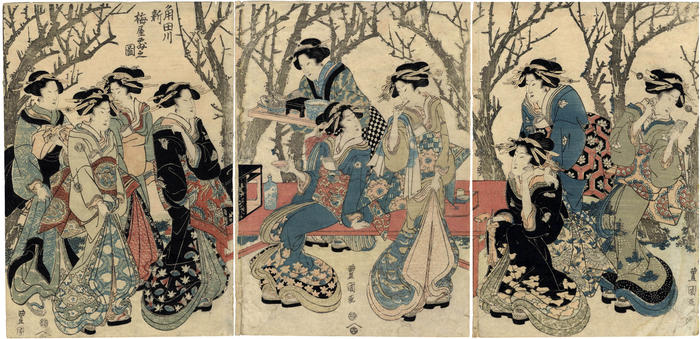Utagawa Toyokuni I (初代歌川豊国) (artist 1769 – 02/24/1825)
The New Plum Estate on the Sumida River or Sumidagawa shin-Umeyashiki no zu (隅田川新梅屋敷之図)
ca 1820
30 in x 14.25 in (Overall dimensions) Japanese color woodblock print
Signed: Toyokuni ga (豊国画)
Publisher: Nishimuraya Yohachi
(Marks 391 - seal 01-008)
Censor's seal: kiwame
Museum of Fine Arts, Boston - center and right panels only
Metropolitan Museum - left panel only
National Diet Library - commentary on a Hiroshige print of the same site
Edo-Tokyo Museum There is a Hiroshige print, the Mukojima Hyakkaen, which is another name for this location. The National Diet Library tells us:
A garden created in 1804 when the antiques dealer Sahara Kiku'u gathered ume plum, susuki silver grass and other ancient Japanese trees and plants and built it in the remains of the residence of the Taga Clan, who were vassals of the Shogun. The name means Mukojima garden of all flowers and is said to have been given in the spirit of the quote by the late Edo Period artist Sakai Hoitsu, who said "the ume plum tree is the foremost of all flowers". Originally, 360 ume plum trees were the main feature, so it was called Shinumeyashiki (new Umeyashiki) in comparison to Kameido's Umeyashi. At present it is a garden run by the prefecture and is designated as a national historic relic and scenic spot.****
The curatorial records at the Met list their copy of the left panel of this triptych as being by Toyokuni I. The Museum of Fine Arts in Boston, which owns bright and fresh copies of the middle and right panels, panels which display fine colors with a striking pink background, say that these prints were designed by Toyokuni II. While the curatorial files of all major museums need careful scrutiny, frequent updating as new information is uncovered and the correction of past mistakes, we feel that stylistically this triptych in the Lyon Collection is closer to the work of Toyokuni I and a date ranging from 1810 to 1815.
****
Mukojima Hyakkaen today
"In 1938, in order to preserve the garden for posterity, the owner gave the garden to the City of Tokyo and it was officially opened to the public as a pay-to-view garden in 1939. In 1978, it was designated by the national government as a famous site of historical significance under the terms of the Cultural Assets Preservation Law."
Quoted from: the Tokyo Metropolitan Park Association web site.
****
There is another copy of this triptych in the Edo-Tokyo Museum.
There are twenty different varieties of ume in the garden today.(JSV)
****
Illustrated
1) in color in Ukiyo-e Masterpieces in European Collections 4: Victoria and Albert Museum I, #123.
2) the far left-hand panel in black and white in Japanese Colour Prints by Utagawa Toyokuni I, Victoria and Albert Museum, 1920, Plate VI.
beautiful woman picture (bijin-ga - 美人画) (genre)
Nishimuraya Yohachi (西村屋与八) (publisher)
Historical - Social - Ephemera (genre)
